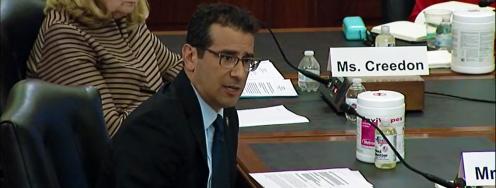Nuclear Submarine Costs Threaten to Sink Shipbuilding Budget
On the radar: Nuclear submarine funding levels unsustainable; ICBMs are old; Sec. Kerry and FMs may join Iran talks; Russia to revamp nuclear missile force; North Korea’s growing capacity to produce nukes; the National Nuclear Insecurity Administration; Japan commits to nuclear security; and Mexico secures stolen radioactive material.
July 8, 2014 | Edited by Lauren Mladenka
Unsustainable funding levels - “The U.S. Navy can’t meet its funding needs for surface warships and a new class of nuclear attack submarines from 2025 to 2034, according to the service’s latest 30-year shipbuilding plan,” writes Tony Capaccio for Bloomberg. “The document outlines challenges facing the plan to increase the Navy fleet to 306 vessels from the current 289 while building 12 new Ohio-class submarines, part of the nation’s nuclear triad of air, land and sea weapons.”
--“The average cost of the Navy plan during the period when the service will be spending the most on the new submarine is $19.7 billion a year, including more than $24 billion at the peak year of fiscal 2032, according to the report. This budget ‘cannot be accommodated by the Navy from existing resources -- particularly if’ the Pentagon remains under congressionally mandated automatic cuts known as sequestration, the report said.” Full article here. http://bloom.bg/1th5SpN
Aging missiles - “The nuclear missiles hidden in plain view across the prairies of northwest North Dakota reveal one reason why trouble keeps finding the nuclear Air Force...The ‘Big Sticks,’ as some call the 60-foot-tall Minuteman 3 missiles, are just plain old,” writes Robert Burns for AP.
--“The Air Force asserts with pride that the missile system, more than 40 years old and designed during the Cold War to counter the now-defunct Soviet Union, is safe and secure. None has ever been used in combat or launched accidentally. But it also admits to fraying at the edges: time-worn command posts, corroded launch silos, failing support equipment and an emergency-response helicopter fleet so antiquated that a replacement was deemed ‘critical’ years ago.”
--“But even as the Minuteman has been updated over the years and remains ready for launch on short notice, the items that support it have grown old. That partly explains why missile corps morale has sagged and discipline has sometimes faltered, as revealed in a series of Associated Press reports documenting leadership, training, disciplinary and other problems in the ICBM force that has prompted worry at the highest levels of the Pentagon.” Read the full article here. http://abcn.ws/1r5SW1E
Ministers join in - “U.S. Secretary of State John Kerry and other foreign ministers from the six powers negotiating with Iran on its nuclear programme may travel to Vienna soon to join the talks,” write Louis Charbonneau and John Irish in Reuters. “‘The ministers can help negotiate an extension of the negotiations, if that's deemed useful, and they could help generate momentum to get a deal by July 20, which remains our goal,’ a Western close to the talks diplomat told Reuters on condition of anonymity.”
--“It was not clear when the ministers would come to the Austrian capital, if they decide to do so, though some diplomats suggested it could be as early as the end of this week. Others said a later date was more likely.” Full story here. http://reut.rs/1ogzpHR
Tweet - @armscontrolnow: See: "The P5+1 and Iran Nuclear Talks Alert, July 7" httvia @armscontrolnow #IranTalksVienna #IranDeal p://wp.me/p10vIs-184
Reports:
--“Document: Navy’s 30-Year Shipbuilding Plan for Fiscal Year 2015” in USNI News. http://bit.ly/1mvt2U3
--“Navy Force Structure and Shipbuilding Plans: Background and Issues for Congress” by Ronald O'Rourke for the Congressional Research Service. http://bit.ly/1qfq1qJ
--“CRS Insights Budget Highlight: Air Force Long Range Strike Bomber” by Jeremiah Gertler for the Congressional Research Service. http://bit.ly/1sseuph
Big boost - “North Korea's capacity to produce nuclear warheads could get a big boost when a new reactor becomes operational,” Global Security Newswire reports. “For several years, Pyongyang has been constructing an experimental light-water nuclear reactor at its Yongbyon atomic complex. The North is thought to be almost finished erecting the facility. Once adequate nuclear fuel supplies are available, experts estimate that the process for making the reactor operational will take between 9 and 12 months.”
--“Charles Ferguson, president of the Federation of American Scientists, in an interview with Yonhap published on Sunday said the reactor had the potential to generate enough plutonium annually to fuel 5-6 nuclear warheads. If the reactor is run at high power, and there are no mishaps with its operation, ‘they could probably make 30-40 kilograms just from that reactor’ each year, he said.” Full report here. http://bit.ly/1tjo02e
Nuclear security breakdown - “The National Nuclear Security Administration (NNSA) has mismanaged its mission to secure U.S. nuclear stockpiles and classified research sites so badly that renaming it the National Nuclear Insecurity Administration hardly would be an exaggeration,” writes The Tribune-Review in an editorial. “A new Government Accountability Office report traces the agency's woes to its 2009 attempt ‘to reform its security measures in a bid to cut costs of about $53 million,’ according to The Washington Free Beacon. Allowing independent security contractors ‘greater authority,’ the agency actually ‘increased security risks and reduced security performance,’ the GAO says.”
--“The premise that no savings can justify inadequate U.S. nuclear-weapons security should have been self-evident to the NNSA but apparently wasn't. Thus, all necessary steps now must be taken to reverse the agency's bungling — so that America won't shoot itself in the foot this way again.” Full piece here. http://bit.ly/1tjqZaZ
Revamps in store - “Russia on Friday said it plans to finish modernizing its nuclear-capable missile forces within several years,” Global Security Newswire reports. "’By 2016, the share of new missile systems will reach nearly 60 percent, and by 2021 their share will increase to 98 percent,’ said Col. Igor Yegorov, a defense ministry spokesman for Russia's Strategic Missile Forces. The project would replace Russia's active-duty, nuclear-ready missiles left over from the Cold War.”
--“Yegorov said the upgrades would include systems designed to circumvent missile-defense technology employed by other countries, as well as improvements to their ‘troop- and weapon-command systems [and] combat equipment.’" Full piece here. http://bit.ly/1rMIwql
Tweet - @BulletinAtomic: Japan's missing plutonium? Found it! #Japan #energy #nuclearow.ly/yUx0B
Signing on - “An international pact on heightened security standards for nuclear materials got one step closer to being implemented when Japan signed on late last month,” writes Rachel Oswald in Global Security Newswire. “The island nation's signing of the Amendment to the Convention on the Physical Protection of Nuclear Material means that another 22 countries are required to do the same before the pact can enter into force, according to a Friday International Atomic Energy Agency press release.”
--“To date, 77 nations have signed the amendment, which was drafted in 2005 and requires signatories to take certain steps to safeguard civilian atomic facilities and stockpiles of nuclear material. The measures apply to material in active use, in storage and in transit. The amendment also provides a framework for nations to cooperate in rapidly responding to incidents where atomic materials go missing or are stolen. The United States has yet to ratify the amendment, as implementing legislation remains stuck in Congress.” Full article here. http://bit.ly/1mEXZGV
Radioactive material secured - “Mexican officials on Friday located and secured a quantity of sensitive radioactive material that had been stolen a day earlier,” Global Security Newswire reports. “A truck transporting a container of iridium-192 was seized by thieves in the Mexico City suburb of Tlalnepantla, according to a Twitter post by the chief of Mexico's civil protection agency. The highly radioactive material was later discovered discarded but still in its specialized container on a road several miles from where the vehicle was stolen.” Full story here. http://bit.ly/1jljnR4
Quick-hits:
--“Two Decades After Kim Il Sung’s Demise, A Look Back at Hope, Fears” by Jonathan Cheng in The Wall Street Journal. http://on.wsj.com/1oxghGZ
--“Hacked Israeli Military Twitter Account Declared ‘Nuclear Leak’” in Global Security Newswire. http://bit.ly/1mEM0cC
--“Eduard Shevardnadze helped change the world” by The Washington Post Editorial Board. http://wapo.st/1qGXTig
Events:
--“The Future of International Civilian Nuclear Cooperation.” House Foreign Affairs Committee Hearing with Henry Sokolski, Daniel Lipman, and Leonard Spector. July 10 at 9:45 at 2172 Rayburn House Office Building. Webcast on committee website. http://1.usa.gov/1kl9XQe
--2014 National Public Opinion Survey of Iranian Americans Findings. Briefing and discussion with Alireza Nader, Barbara Slavin, and Alex Vatanka. July 10 from 12:00-1:30 at H-137, The Capitol. RSVP by email to Adrienne Varkiani at adrienne@paaia.org or (202) 828-8370
--“Generation Prague: Innovation in International Security.” Annual Conference with Sen. Chris Murphy (D-CT), Sigrid Kaag, Frank Klotz, Rose Gottemoeller, Tom Countryman, Andrew Weber, and other. July 10 at the U.S. Department of State, East Auditorium, George Marshall Conference Center. More information and RSVP here. http://1.usa.gov/1nPgROR
--“Nuclear Centers of Excellence in Asia: Next Steps.” Discussion with Kazunori Hirao, Laura Holgate, and 11 other speakers. July 18 at the Center for Strategic and International Studies, 212-A/B Conference Room, 1616 Rhode Island Ave. NW. RSVP by email to Robert Kim at rkim@csis.org



